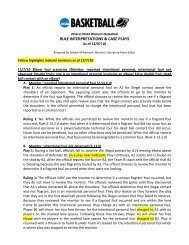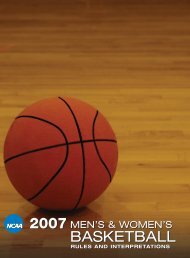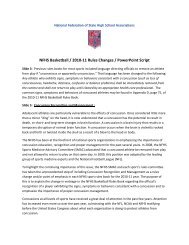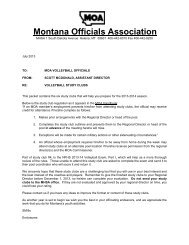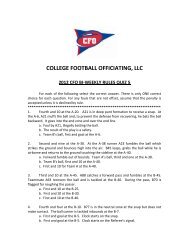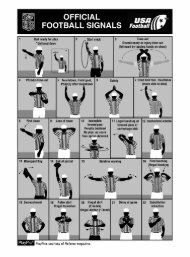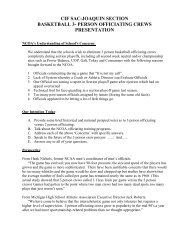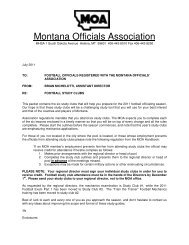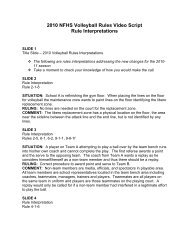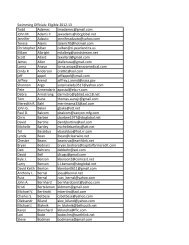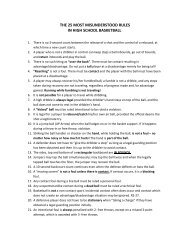MONTANA OFFICIALS ASSOCIATION - MOA - ArbiterSports
MONTANA OFFICIALS ASSOCIATION - MOA - ArbiterSports
MONTANA OFFICIALS ASSOCIATION - MOA - ArbiterSports
Create successful ePaper yourself
Turn your PDF publications into a flip-book with our unique Google optimized e-Paper software.
attempt to play the ball, it is a legal play. If you deem it was not an attempt to play the ball, it<br />
should be called an unsporting technical foul.<br />
On a loose ball, do not let a player jump on, or push through another player to gain an advantage.<br />
There is a misconception that during a loose ball, any contact is legal. All illegal contact rules still<br />
apply.<br />
Whether it is indirect or direct, the coach loses his or her coach’s box privileges.<br />
A single flagrant, a second direct technical or third technical of any kind results in disqualification.<br />
A substitute becomes a legal player when the ball becomes live, even if entered illegally.<br />
If a player is injured and trainer or coach comes onto the court, the player must be removed<br />
unless a time out is called to buy the player back in.<br />
Screens, on a stationary opponent, from behind, must allow one step to avoid contact. On a<br />
moving opponent, they must allow time and distance. Screener should be no wider than shoulder<br />
width apart; contact may be severe, but legal. A screening player can move. If there is no contact,<br />
there can be no foul.<br />
During play, a player who runs off the court with or without the ball (usually to avoid a screen or<br />
other players) has committed a violation.<br />
On a throw-in, a player who does not return directly to the court, as a deceptive advantage has<br />
illegally gained the advantage. It is a technical foul, not a violation.<br />
Excessively swinging the arms or elbows (without contact) is a violation.<br />
A kicking violation is an intentional strike with the leg or foot. A pass off a defender’s leg is not a<br />
kick.<br />
A box out is securing position. Displacement is a foul!<br />
Use this list in your pregame discussions to help cover a wide range of topics in a short amount of<br />
time. Use your pregame time wisely!<br />
IV Discuss and review the following:<br />
2012-13 NFHS BASKETBALL RULES INTERPRETATIONS<br />
Publisher’s Note: The National Federation of State High School Associations is the only source of official high school<br />
interpretations. They do not set aside nor modify any rule. They are made and published by the NFHS in response to<br />
situations presented. Robert B. Gardner, Publisher, NFHS Publications © 2012<br />
SITUATION 1: While A1's free throw is in flight, B1, in a marked lane space, enters the lane. A1's free<br />
throw hits the ring and bounces straight up and hits a wire over the basket or hits the ring and goes over<br />
the backboard. RULING: The official should sound the whistle and call a violation on B1. A1 is given a<br />
substitute free throw. (9-1-4 Penalty 2b)<br />
SITUATION 2: Team A has a designated spot throw-in along the end line. Thrower A1 extends the ball<br />
with his/her arms over the end line such that part of the forearms, hands and the ball are entirely on the<br />
inbounds side of the boundary line. B2 slaps A1 on the wrist and dislodges the ball. RULING: When a<br />
defender makes contact with a thrower-in, the result is an intentional foul. Where A1’s arms are located<br />
(on the inbounds or out-of-bounds side of the boundary line) is immaterial for this penalty to be assessed.<br />
A1 is awarded two free throws and Team A is awarded a throw-in at the spot nearest the foul.<br />
COMMENT: For a boundary-plane violation warning to also be assessed, the defender must actually<br />
violate the rule and penetrate the boundary plane. (4-19-3e; 4-47-1; 7-5-4b; 9-2-10 Penalty 4)<br />
SITUATION 3: A1 is closely guarded by B1 for two seconds in Team A’s frontcourt. B2 then double-teams<br />
A1 and both B1 and B2 are closely guarding A1 for one second. B1 then drops off of A1 to cover another<br />
player. B2 continues to closely guard A1 for two more seconds. RULING: A1 has committed a violation<br />
since he/she was closely guarded continuously for a total of five seconds. (4-10; 9-10-1a)<br />
SITUATION 4: A1 holds the ball for four seconds while B1 obtains a legal guarding position. A1 begins a<br />
dribble and does so for four seconds while B1 maintains a closely guarded position. A1 then holds the<br />
ball for four seconds while being closely guarded. RULING: There is no violation in this situation. Though




